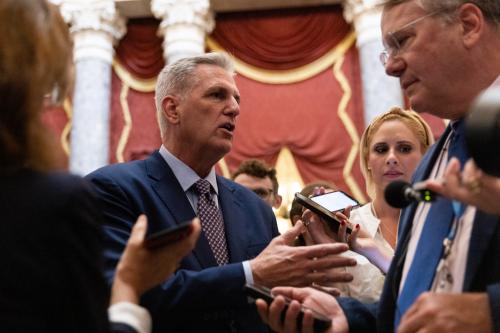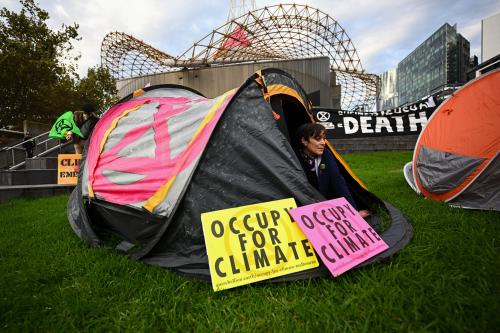Less than a year after the Biden administration proposed forgiving up to $10,000 in federal student loan debt for most borrowers, the Supreme Court ruled the policy unconstitutional. At the core of the case was whether the HEROES Act of 2003 granted the Secretary of Education the authority to “waive or modify” federal student loan terms, up to and including forgiving those loans. The Court ruled in a 6-3 decision that broad forgiveness was beyond the scope of what Congress intended when passing the HEROES Act, further arguing in the majority decision that policies with such a large economic and political impact should be decided through Congress, and not executive action.
In the wake of that decision, the Biden administration has shifted policy toward improving the borrowing process as well as the repayment process. Political attention has focused on repayment (from the Biden administration’s attempts at loan forgiveness to Republican-sponsored legislation proposing new repayment structures) but must also turn to reforming how students decide whether and how much to borrow to ensure future students do not face unmanageable student loan debt.
Short-term policies around loan repayment
With widespread student loan forgiveness struck down by the Supreme Court, the Department of Education (ED) is moving forward on two repayment-oriented efforts. First, the Department has been implementing targeted student loan forgiveness under existing programs. In one recent move, ED announced they had reviewed old income-driven repayment accounts to ensure borrowers received accurate credit for prior monthly payments — as a result about 800,000 borrowers had the rest of their loans forgiven.
The Department is also working to expand student loan forgiveness for students who attended fraudulent universities. In some cases, the administration has automatically forgiven loans for students attending colleges that misrepresented its graduates’ employment rates or that lied about their program accreditation when recruiting prospective students. The administration is also launching a “borrowers defense” application on July 30 where borrowers can make claims against their colleges engaging in misbehavior and request loan forgiveness.
Second, the Biden administration announced the details of their new income-driven repayment plan, with some elements going into effect prior to when student loan repayments restart later this year. The new Saving on a Valuable Education (‘SAVE”) plan will replace REPAYE (an existing income-driven repayment plan) and will automatically transfer borrowers on REPAYE to the new SAVE terms.
The key short-term changes include exempting a higher threshold of income and limiting interest accrual. Borrowers’ monthly payment is calculated off their discretionary income, which has to-date been any income above 150% of the poverty line. Under SAVE, that will be any income above 225% of the poverty line. For a household of four, that means an additional $22,500 of income is protected against consideration when calculating monthly payments. Further, starting this summer if borrowers’ payments don’t cover the interest accrued that month, that interest won’t be charged. Interest accumulation has been a key driver of why some borrowers owe more on their loans four years after graduation than their original balance. While other elements of the plan, such as reducing the years borrowers have to pay before forgiveness, won’t go into effect until next summer, many have argued the new repayment plan is so generous it amounts to a new loan forgiveness program.
Pre-pandemic, the Congressional Budget Office estimated that ED loses 16.9 cents on the dollar for loans in income-driven repayment plans (as opposed to the 12.8 cents on the dollar they gain from loans repaid in standard plans). In its initial review of the Biden administration’s proposed income-driven repayment plan, CBO estimated the program would cost about $230 billion over the next decade, though will update that estimate as the details of the program get finalized.
Challenges restarting payments
Millions of borrowers have had their student loan payments on pause since March 2020, but a provision in recent debt ceiling negotiations stipulated that the pause must end this year and payments will resume this fall. One analysis estimates about 16% of borrowers could be unprepared to make their student loan payment, recommending ED double-down on enrolling borrowers in existing income-driven repayment plans and calls on states and employers to provide assistance navigating loan repayment.
At the federal level, the Biden administration announced that borrowers would not face any negative credit consequence of non-payment until September 30, 2024 during a repayment “on ramp” period. While this action will help borrowers avoid default, it is incumbent on the administration to clearly communicate to borrowers that interest will still accumulate on their loans, so borrowers aren’t surprised by increasing debt balances.
Widespread loan forgiveness: Negotiated rulemaking
The administration has not stopped pursuing widespread student loan forgiveness. But these actions must be taken through the authority granted to the Secretary of Education under the Higher Education Act (HEA). The administration now turns to a long, complicated process called “negotiated rulemaking,” (commonly abbreviated as “neg reg” or “reg neg”) to advance student loan forgiveness.
This Brookings explainer details the negotiated rulemaking process from 2021 when ED convened a committee around student loan forgiveness rulemaking. At a high level, ED must craft a negotiating committee, which will hold hearings and vote on proposed actions, and then ED will propose rules based on committee consensus. These phases can take a long time — but ED is moving quickly and the 2023-24 negotiated rulemaking process is already underway.
There are two key timing considerations for implementation. ED must propose rules by November 1 for them to go into effect by the following July — meaning the Department will likely announce final rules on student loan forgiveness just days before the November 2024 presidential election, raising the stakes on implementation. A new presidential administration could potentially pause implementation and move to formally rescind a federal rule, as former Secretary of Education Betsy DeVos did in 2019 when she rescinded a “gainful employment” rule regulating career programs’ eligibility for federal financial aid that had been passed under the Obama administration.
There’s another date to consider — the end of 2025. Most types of student loan forgiveness are subject to taxation, but the American Rescue Plan has a provision that federal student loan discharges are not subject to federal taxation through December 31, 2025 (and most, though not all, states have followed suit). This deadline makes it even more pressing for borrowers that neg-reg rules get submitted by November 2024 so they can be implemented in the second half of 2025 before the tax exemption expires.
Legal challenges ahead?
Federal rulemaking is subject to judicial review, and whatever rules emerge from the current neg-reg process will almost certainly face legal challenge. However, based on the Administrative Procedural Act, those challenges will be unlikely to come until late 2024 once there has been “final agency action” (e.g., when the final rule is posted). Of course, a legal challenge to one rule does not preclude another attempt from an agency. When the Obama administration was crafting gainful employment regulations, their first proposal was struck down, after which they changed the metrics they would use to evaluate colleges and proposed a new rule that was upheld against legal challenges. This may be the first of multiple rulemaking processes around student loan forgiveness and how to best structure loan repayment.







Commentary
The long path forward for student loan forgiveness
July 28, 2023